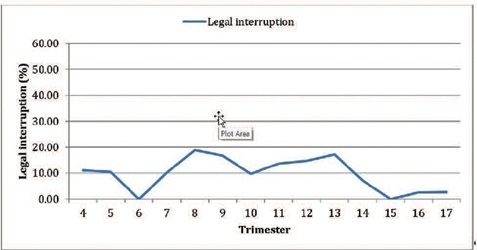-
Original Article
The Impact of the COVID-19 Pandemic on the Care of Women Experiencing Abortion in a University Hospital in Brazil
Revista Brasileira de Ginecologia e Obstetrícia. 2023;45(3):113-120
07-10-2023
Summary
Original ArticleThe Impact of the COVID-19 Pandemic on the Care of Women Experiencing Abortion in a University Hospital in Brazil
Revista Brasileira de Ginecologia e Obstetrícia. 2023;45(3):113-120
07-10-2023Views150Abstract
Objective
To evaluate the impact of the coronavirus disease 2019 (COVID-19) pandemic on the care of patients with miscarriage and legal termination of pregnancy in a university hospital in Brazil.
Methods
A cross-sectional study of women admitted for abortion due to any cause at Hospital da Mulher Prof. Dr. J. A. Pinotti of Universidade Estadual de Campinas (UNICAMP), Brazil, between July 2017 and September 2021. Dependent variables were abortion-related complications and legal interruption of pregnancy. Independent variables were prepandemic period (until February 2020) and pandemic period (from March 2020). The Cochran-Armitage test, Chi-squared test, Mann-Whitney test, and multiple logistic regression were used for statistical analysis.
Results
Five-hundred sixty-one women were included, 376 during the prepandemic period and 185 in the pandemic period. Most patients during pandemic were single, without comorbidities, had unplanned pregnancy, and chose to initiate contraceptive method after hospital discharge. There was no significant tendency toward changes in the number of legal interruptions or complications. Complications were associated to failure of the contraceptive method (odds ratio [OR] 2.44; 95% confidence interval [CI] 1.23–4.84), gestational age (OR 1.126; 95% CI 1.039–1.219), and preparation of the uterine cervix with misoprostol (OR 1.99; 95% CI 1.01–3.96).
Conclusion
There were no significant differences in duration of symptoms, transportation to the hospital, or tendency of reducing the number of legal abortions and increasing complications. The patients’ profile probably reflects the impact of the pandemic on family planning.
Key-words AbortionCLAP MUSA networkCOVID-19EviSIPperinatal information systempopulation surveillanceSee more
-
Original Article
Factors Associated with Abortion Complications after the Implementation of a Surveillance Network (MUSA Network) in a University Hospital
Revista Brasileira de Ginecologia e Obstetrícia. 2021;43(7):507-512
10-18-2021
Summary
Original ArticleFactors Associated with Abortion Complications after the Implementation of a Surveillance Network (MUSA Network) in a University Hospital
Revista Brasileira de Ginecologia e Obstetrícia. 2021;43(7):507-512
10-18-2021Views152See moreAbstract
Objective
To evaluate the factors associated with abortion complications following the implementation of the good-practice surveillance network Mujeres en Situación de Aborto (Women Undergoing Abortion, MUSA, in Spanish).
Methods
A cross-sectional study withwomen who underwent abortion due to any cause and in any age group at UNICAMP Women’s Hospital (part of MUSA network), Campinas, Brazil, between July 2017 and Agust 2019. The dependent variable was the presence of any abortion-related complications during hospitalization. The independent variables were clinical and sociodemographic data. The Chi-square test, the Mann-Whitney test, and multiple logistic regression were used for the statistical analysis.
Results
Overall, 305 women were enrolled (mean±standard deviation [SD] for age: 29.79±7.54 years). The mean gestational age was 11.17 (±3.63) weeks. Accidental pregnancy occurred in 196 (64.5%) cases, 91 (29.8%) due to contraception failure. At least 1 complication was observed in 23 (7.54%) women, and 8 (34.8%) of them had more than 1. The most frequent complications were excessive bleeding and infection. The factors independently associated with a higher prevalence of complications were higher gestational ages (odds ratio [OR]: 1.22; 95% confidence interval [95%CI]: 1.09 to 1.37) and contraceptive failure (OR: 3.4; 95%CI: 1.32 to 8.71).
Conclusion
Higher gestational age and contraceptive failure were associated with a higher prevalence of complications. This information obtained through the surveillance network can be used to improve care, particularly in women more susceptible to unfavorable outcomes.


